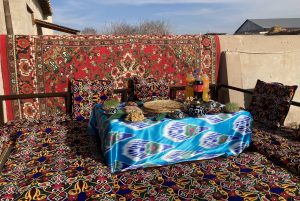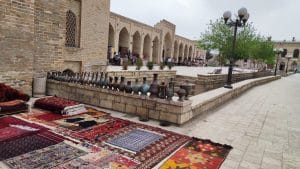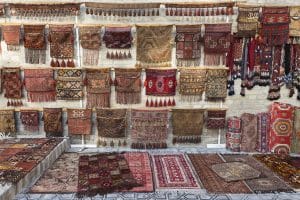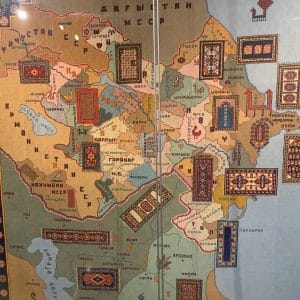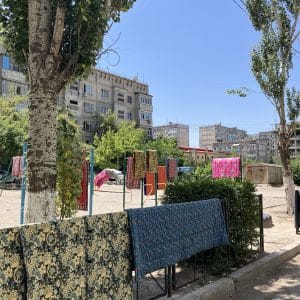History of Central Asian Weaving
Central Asia has one of the world’s oldest traditions of carpet weaving. The oldest known carpet, dating back 2,000 years, was found in the Pazyryk Valley—located in present-day southern-central Russia near the Kazakh and Mongolian borders. At the time, the valley was inhabited by the Scythians, nomadic tribes who roamed Central Asia before the Mongol conquest. Some scholars believe the carpet may have been made by Armenians or Persians, whose sedentary lifestyles better supported the complex infrastructure required for rug weaving. Regardless of its origin, the carpet’s presence in the Pazyryk Valley reflects both the use of woven rugs by nomadic peoples and the sophistication of regional trade networks even in ancient times.
Farther south, interactions between nomadic and sedentary groups continued to shape the craft and economy of rug weaving. Among the Kyrgyz and Kungrat tribes of Kyrgyzstan and Uzbekistan, respectively, carpets, both woven and felt, were fully integrated into daily life. Rugs served both practical and decorative purposes in yurts: insulating floors, serving as folded furniture, or hanging to divide the large yurt space into rooms. Rugs also enhanced the yurt’s appearance, providing warmth and beauty in what could be a harsh climate. A bride’s dowry traditionally included rugs she had created. Their craftsmanship reflected her skill and readiness for married life.
In major cities like Samarkand, rug weaving developed into a thriving industry, especially under the generous patronage of Amir Timur. Spanish ambassador Ruy González de Clavijo, writing of his visit to the Timurid court in 1404, described silk rugs embroidered with gold thread.
In the 19th century, as Russian imperial forces expanded into Central Asia, carpet weaving became part of the empire’s efforts to study and classify the region’s diverse peoples. Russian scholars published academic works that asserted intellectual authority over local knowledge, displacing traders and artisans in shaping the narrative. These publications and exhibitions brought Central Asian carpets to a broader audience in Russia and abroad.
Under the Soviet Union, rug weaving was repurposed to fit socialist ideals. Factories replaced homes as the main sites of production, and portrait carpets (kovry-portrety) featuring Lenin and Stalin became popular as cults of personality arose. As art historian Vera-Simone Schulz notes, these rugs were celebrated as a way for Turkmen and other groups located on the edges of the country to participate in Soviet visual culture. Traditional weaving continued, but the process was industrialized and collectivized.
Today, both local and international organizations are working to revive traditional rug weaving as a cultural and artistic heritage practice.
Technical Details and Design
Rugs in Central Asia generally fall into two categories: flat weave and pile. Flat weaves are made with long, continuous strands that create a tight, smooth surface, while pile rugs have cut fibers that give them a fur-like texture. Flat weaves are quicker and cheaper to produce and are typically used as floor coverings, while pile rugs, with their softer and more luxurious feel, are often used as wall décor.
Rug making begins with forming the base—the structural foundation made from cotton, camel wool, or goat wool, all valued for their strength and low elasticity. The weave, worked through this base, is made from sheep wool, which is softer, more flexible, and better at absorbing dyes, making it ideal for crafting detailed patterns and comfortable textures.
The material is first cleaned, brushed, and spun into thread using vertical looms, which allow fibers to be stretched and twisted into even, durable strands. This process, typically done by hand and often by women, requires both strength and skill to ensure the thread is even and strong enough for weaving. The spun thread is then woven on horizontal looms, usually laid flat on the ground. The warp threads are stretched across the frame, while the weft is woven through them to create flat weaves or tied into knots to form pile.
Large carpets can be woven in sections and stitched together. Natural dyes made from roots, flowers, and fruit juices were once used—for instance, black was created by boiling iron or walnut peels with pomegranate rinds.
Often, women work in groups. A pair of National Geographic journalists traveling Turkmenistan in 1973 described the process: “A weaver…knots a strand of wool around a thread of warp, cutting the ends with the sickle-shaped knife. After each row she tamps the line with a heavy comb. Finally, using shears, she clips several inches of shaggy tuft to an even height. The weavers work with every ounce of their energy, burying their joys and sorrows alike in their carpets, forgetting even the baby in its hammock hung above the loom.”
Zoomorphic and phytomorphic designs are popular motifs that likely began as detailed depictions of real beings rooted in local shamanistic beliefs, but gradually simplified into geometric shapes. In Kyrgyzstan, in regions near the Ferghana Valley, common decorative motifs include the curl (kaykalak), hoof (tai tuyak), wolf’s eye (boru gozu), knife tip (bychak uchu), star (jyldyz), and dog’s paw (ala monchok). The octagonal “kalkaanushka” emblem, originating with the Oghuz tribes between the Caspian and Aral seas, appears across Turkic carpets—including Azerbaijani—highlighting migration and cultural exchange. Historically, carpet emblems served as tribal coats of arms, a significance that endures today: Turkmenistan’s flag features five emblems representing its main tribes—Salor, Yomut, Tekke, Chaudor, and Saryk. This tradition is so central to national identity that Turkmen Carpet Day is celebrated annually on the last Sunday of May.
Carpets are a means of learning about Central Asia’s history, culture, and economy. It is an integral part of Kyrgyz identity, Uzbek identity, and many others. A trip to the region would be incomplete without a tour of a crafts museum or applied arts workshop such as these in Bishkek!
You’ll Also Love

World Nomad Games
The World Nomad Games is a unique international sporting event that celebrates the traditional sports and cultural heritage of the traditionally nomadic Turkic people. The World Nomad Games brings together athletes and spectators from around the world to participate in nomadic traditions through a festival of traditional sports, cultural events, and art exhibitions. The next […]
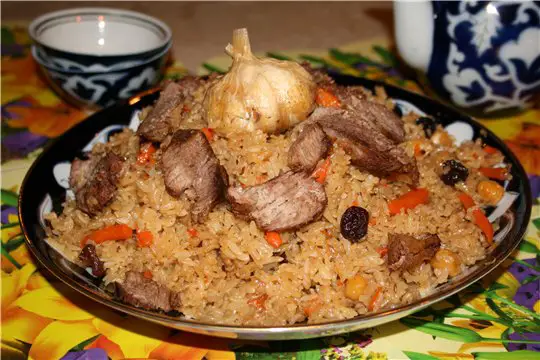
Plov: A Central Asian Rice Staple
Plov (Плов) is a hearty dish made from deep fried meat and vegetables, over which rice is cooked. Plov is considered a national dish in many countries of Central Asia and the Near and Middle East ‒ Iran, Tajikistan, Uzbekistan, and Afghanistan. It is generally popular over most of the area that the Soviet Union […]

Halva, Halwa, Helva: A Hundred Sweets from Dozens of Cultures
Halva, the rich dessert well-loved across many cultures, is so densely filling it almost manages to feel like a meal – and not an entirely unhealthy one at that. There are more than one hundred varieties of halva, an ancient dish whose base can be flour, ground seeds or nuts, or fruit, depending on where […]

Cheburek: The Half-moon Pastry from Crimea
On streets throughout the post-Soviet space, you can generally find the “чебурек” (cheburek) — a juicy, fried, savory pastry — for sale. This tasty treat likely originated in Turkey or Crimea and its popularity slowly traveled north and eventually spread throughout what is today the former USSR. Why It’s Called “Cheburek” (Почему они носят такое […]
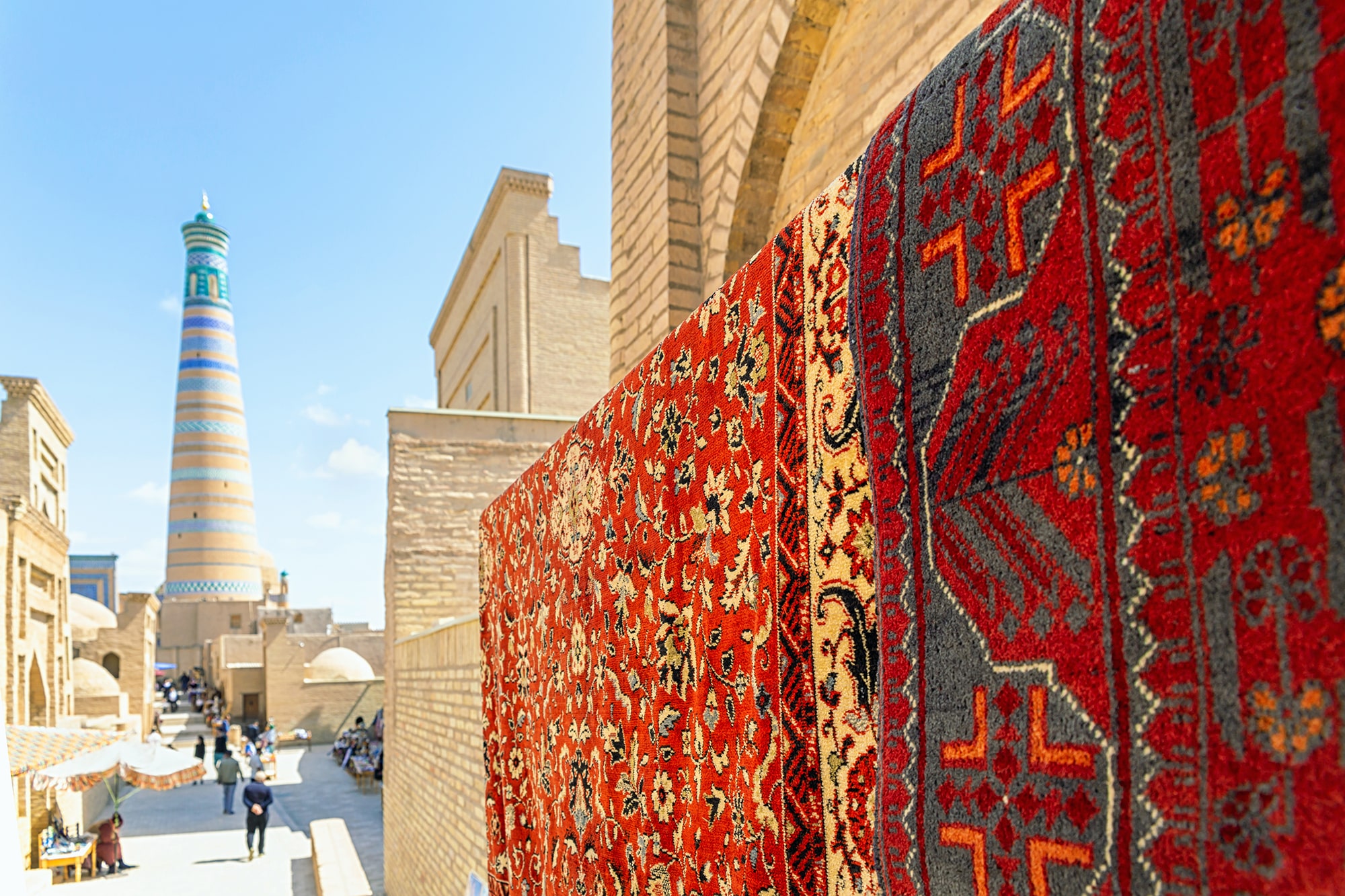
Knots of Culture: Central Asia’s Carpet Weaving Heritage
Central Asia’s rich tradition of carpet weaving reflects the region’s history, culture, and identity. From the ancient nomads of the Pazyryk Valley to the artisans of Kyrgyz yurts and the urban weavers of Samarkand, carpets have long served both practical and symbolic functions. Their materials, techniques, and motifs reflect centuries of interaction between nomadic and […]

